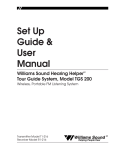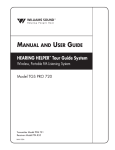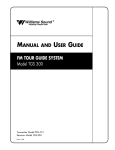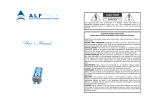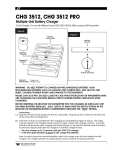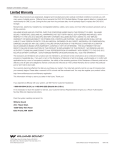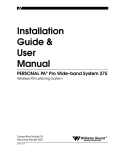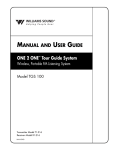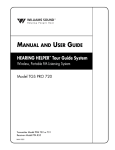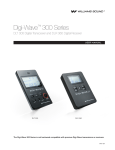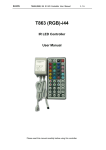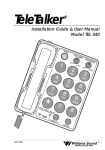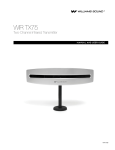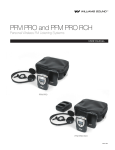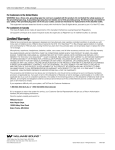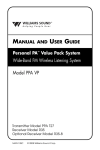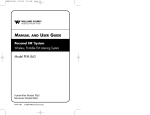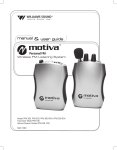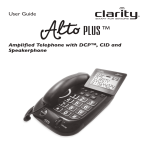Download TGS 863 Manual
Transcript
MANUAL AND USER GUIDE Whisper™ Tour Guide System Wireless, Portable FM Listening System Model TGS 863 Transmitter Model T863 Receiver Model R863 MAN 130B © 2007 Williams Sound Corp. WHISPER™ FM TOUR GUIDE SYSTEM, MODEL TGS 863 INSTALLATION GUIDE & USER MANUAL CONTENTS PAGE System Overview . . . . . . . . . . . . . . . . . . . . . . . . . . . . . . . . . . .4 System Components . . . . . . . . . . . . . . . . . . . . . . . . . . . . . . . . .6 T863 Transmitter . . . . . . . . . . . . . . . . . . . . . . . . . . . . . . . . .6 Microphones . . . . . . . . . . . . . . . . . . . . . . . . . . . . . . . . . . . .6 R863 Receiver . . . . . . . . . . . . . . . . . . . . . . . . . . . . . . . . . . .8 Optional Earphones & Headphones . . . . . . . . . . . . . . . . . .8 Safety Information . . . . . . . . . . . . . . . . . . . . . . . . . . . . . . . . .10 Recycling Instructions . . . . . . . . . . . . . . . . . . . . . . . . . . . . . .11 Operating Instructions . . . . . . . . . . . . . . . . . . . . . . . . . . . . . .12 T863 Transmitter . . . . . . . . . . . . . . . . . . . . . . . . . . . . . . . .12 R863 Receiver . . . . . . . . . . . . . . . . . . . . . . . . . . . . . . . . . .15 Belt Clip . . . . . . . . . . . . . . . . . . . . . . . . . . . . . . . . . . . . . .17 Hints for Using the System . . . . . . . . . . . . . . . . . . . . . . . .18 Battery Information . . . . . . . . . . . . . . . . . . . . . . . . . . . . . . . .19 Battery Installation . . . . . . . . . . . . . . . . . . . . . . . . . . . . . .19 Rechargeable & Non-rechargeable Batteries . . . . . . . . . .20 Using Optional Battery Chargers . . . . . . . . . . . . . . . . . . .21 In Case of Difficulty . . . . . . . . . . . . . . . . . . . . . . . . . . . . . . . .22 Warranty . . . . . . . . . . . . . . . . . . . . . . . . . . . . . . . . . . . . . . . . .24 System Specifications . . . . . . . . . . . . . . . . . . . . . . . . . . . . . . .26 3 SYSTEM OVERVIEW The Whisper™ Tour Guide System is a portable, high-performance, wireless system composed of the T863 Transmitter and R863 Receivers designed for use in guided tour applications. The system allows one-way transmission of a tour guide’s voice to group members using an FM radio signal. Using the system helps group members overcome background noise and distance from the person speaking. The Whisper™ System can be used for large or small tour groups in noisy or quiet environments. Your Whisper™ Tour Guide System has two principal parts: the transmitter and the receiver. Much like a miniature radio station, the transmitter and microphone pick up the sound of a speaker’s voice and broadcast it over an FM radio signal. The receivers are used with earphones or headphones to pick up the broadcast up to 30 meters away. To avoid difficulties, please read through these instructions as you begin to use the system. Then save them for questions that arise as you continue to use your system. If you have problems with the Whisper™ Tour Guide System, don’t hesitate to call Williams Sound at 1-800-328-6190 (U.S.A.) or +1 952-943-2252 (Outside the U.S.A.), or visit www.williamssound.com. 4 FIG. 1: HOW THE TOUR GUIDE SYSTEM WORKS The tour guide wears the body-pack transmitter and head worn microphone. The guide’s voice is broadcast as an FM radio signal over a distance of up to 30 meters (98.4 feet). Listeners use the receiver with an earphone or headphone to hear the speaker’s voice directly, with reduced background noise. A neckloop telecoil coupler allows the system to be used with telecoil (T-Switch) equipped hearing aids, at somewhat reduced range. 5 SYSTEM COMPONENTS Body Pack Transmitter (T863) with (2) AA batteries (BAT 001) and belt clip (CLP 015) Noise-cancelling headband microphone (MIC 086) (20) Personal FM Receivers (R863) with batteries (BAT 001) and belt clips (CLP 015) Instruction Manual (MAN 130) System carry case (CCS 030) THE T863 TRANSMITTER The T863 is a battery operated, body-pack style transmitter; it is equipped with a head-worn microphone to pick up the tour guide's voice. The transmitter produces an FM radio signal to broadcast the tour guide's voice to the receiver units. The transmitter turns on when the rotary switch is turned to the “1” or “2” or “3” position; the transmitter turns off when the rotary switch is turned to the “ ” power icon position. The T863 operates on two AA non-rechargeable alkaline batteries (BAT 001), or two AA rechargeable NiMH batteries (BAT 026). MICROPHONES A noise-cancelling electret headband microphone (MIC 086) is the standard microphone. The noise-cancelling microphone helps to reduce background sounds in noisy environments. The microphone plugs into the “Microphone” jack on top of the Transmitter. The microphone should be positioned directly in front of the tour guide's mouth to achieve an optimal signal to noise ratio and so that head movement does not affect the loudness of the signal. 6 Optional Microphones An optional Hearing Protector Headset Microphone (MIC 036) is available for extremely high noise environments. It features ear muffs that completely cover both ears and provides 24 dB noise isolation for hearing protection. Two optional lapel “clip on” style microphones are available for use in quieter environments like museums or galleries: 1) The MIC 090 lapel mic has an omnidirectional pick-up pattern for picking up sounds in a surrounding area; 2) The MIC 054 has a directional (or cardioid) pick-up pattern, which can be used to pick sounds closest to the listener (helps to reduce background noise). An optional hand-held microphone (MIC 027) is available for tour guides who prefer to hold the microphone. FIG. 2: MICROPHONE OPTIONS MIC 027 MIC 036 MIC 054 MIC 086 MIC 090 7 THE R863 RECEIVER The R863 is a battery-powered, body-pack style receiver; it is used with an earphone or headphone (not included) to hear the signal produced by the transmitter. The receiver is tuned to the corresponding channel of the transmitter (“1” or “2” or “3” switch position) and has a user-adjustable volume control. The earphone or headphone plugs into the “ ” jack on top of the Receiver. The receiver turns on when the rotary switch on the unit is turned to the “1” or “2” or “3” position; the receiver turns off when the rotary switch is turned to the “ ” power icon position. The R863 Receiver operates on two AA non-rechargeable alkaline batteries (BAT 001) or two AA rechargeable NiMH batteries (BAT 026). OPTIONAL HEADPHONES AND EARPHONES The EAR 022 Surround Earphone offers excellent sound quality in a unique style that hangs on the ear. The earphone plugs into the “ ” jack on top of the Receiver. For cleaning, an alcohol swab can be used to wipe down the earphone after use. Note: The EAR 022 should not be immersed in water or other cleaning agent. The EAR 022 is not recommended for high noise environments. The HED 008 is a heavy-duty, hearing-protector headset. The HED 008 earmuffs completely cover the ears and provide 24 dB noise isolation for hearing protection in high noise environments. The EAR 013 and EAR 014 are single and dual Mini Earphones. The earbud-style features a foam covering that fits in the outer ear. The foam pads can be removed for cleaning or replacement. Replacement pads (EAR 015-10) are available. 8 The stylish HED 026 rear-wear headphone offers excellent sound quality; it rests comfortably over the ears and wraps around the back of the head for a less obtrusive, relaxed fit. The classic HED 021 headphone is adjustable in size to accommodate a variety of users. Featuring excellent sound quality and a comfortable wear, the HED 021 meets the demands for any listening application. FIG. 3: EARPHONE / HEADPHONE OPTIONS R HED 008 HED 021 HED 026 EAR 022 EAR 013 EAR 014 9 SAFETY INFORMATION HEARING SAFETY: CAUTION! The receiver is designed to amplify sounds to a high volume level which could potentially cause hearing damage if used improperly. To protect your hearing and the hearing of others: 1. Make sure the volume is turned down before putting on the earphone or headphone. Then adjust the volume to a comfortable level. 2. Set the volume level at the minimum setting that you need to hear. 3. If you experience feedback (a squealing or howling sound), reduce the volume setting and move the microphone away from the earphone or headphone. 4. Do not allow children or other unauthorized persons access to this product. BATTERY SAFETY AND DISPOSAL: CAUTION! The transmitter and receiver are supplied with disposable Alkaline batteries. Do not attempt to recharge disposable batteries, which may explode, release dangerous chemicals, cause burns, or other serious harm to the user or product. 10 PACEMAKER SAFETY: CAUTION! 1. Before using this product with a pacemaker or other medical device, consult your physician or the manufacturer of your pacemaker or other medical device. 2. If you have a pacemaker or other medical device, make sure that you are using this product in accordance with safety guidelines established by your physician or the pacemaker manufacturer. RECYCLING INSTRUCTIONS Help Williams Sound protect the environment! Please take the time to dispose of your equipment properly. Product Recycling for Customers in the European Union: Please do NOT dispose of your Williams Sound equipment in the household trash. Please take the equipment to an electronics recycling center; OR, return the product to the factory for proper disposal. Battery Recycling for Customers in the European Union: Please do NOT dispose of used batteries in the household trash. Please take the batteries to a retail or community collection point for recycling. 05/09/07 11 OPERATING INSTRUCTIONS USING THE T863 TRANSMITTER FIG. 4: T863 TRANSMITTER VIEWS "On" Indicator LED On/Off/Channel Selector Switch Microphone Jack Antenna T863 Top T863 Front 12 Note: Rechargeable batteries are shipped in a discharged state and must be charged overnight before using. 1. Make sure there are two charged AA batteries in the transmitter. If batteries are not installed, see Battery Information on page 19. 2. Plug the microphone cord into the “Microphone Jack” on top of the transmitter. 3. Turn the unit on: turn the On/Off/Channel switch to position “1” or “2” or “3.” The Power “ON” LED indicator should illuminate Red. 4. Select a desired operating frequency. To operate on 863.25 MHz, turn the On/Off/Channel switch to position “1”; to operate on 863.75 MHz, turn to position “2”; to operate on 864.75 MHz, turn to position “3.” Important: The receiver will need to match the operating frequency on the transmitter for the tour guide system to work properly. 5. Position the Headset Microphone boom as close to the speaker's mouth as possible without actually touching. Lapel Clip microphones should be attached to a collar or lapel, as close to the speaker's mouth as possible. The transmitter can be placed in a pocket, or clipped onto a belt or waistband. IMPORTANT: When the T863 transmitter is not being used, remember to turn the unit OFF by turning the On/Off/Channel switch to the “ ” power icon position. The Power “ON” LED indicator should not be lit. 13 USING THE T863 TRANSMITTER, FIG. 5: MIC GAIN ADJUST CONT. ON T863 TRANSMITTER Mic Adjust – AA + + AA – Mic Adjust If necessary, the microphone gain control on the T863 transmitter can be increased or decreased to meet the demands of specific listening applications. Instructions: 1. Open the battery compartment by lifting the tab on the back of the transmitter with your finger. 2. Refer to FIG. 5 above to locate the microphone gain control. 3. Using a tuning wand or small screwdriver, turn the gain control fully counterclockwise to reduce the gain. Turn the gain control fully clockwise to increase the gain. 4. Close the battery compartment door. 14 USING THE R863 RECEIVER FIG. 6: R863 RECEIVER VIEWS On/Off/Channel Selector Switch "On" Indicator LED O Earphone/Headphone Jack Volume Control R863 Top R863 Front 15 USING THE R863 RECEIVER, CONT. Note: Rechargeable batteries are shipped in a discharged state and must be charged overnight before using. 1. Make sure there are two alkaline or rechargeable AA batteries in the Receiver. If batteries are not installed, see Battery Information on page 19. 2. Plug the earphone or headphone into the “ ” Jack on top of the Receiver. For earphone/headphone options, see pages 8-9. 3. Put on the earphone or place the headphones over your ears. 4. Turn the unit on: turn the On/Off/Channel switch to position “1” or “2” or “3.” The Power “ON” LED indicator should illuminate Red. 5. Select a desired operating frequency. To operate on 863.25 MHz, turn the On/Off/Channel switch to position “1”; to operate on 863.75 MHz, turn to position “2”; to operate on 864.75 MHz, turn to position “3.” Important: Make sure the receiver is operating on the same frequency as the transmitter! The receiver’s channel switch (1-2-3 position) should match the transmitter’s channel switch. 6. Adjust the receiver volume control to a comfortable listening level. You should be able to hear someone speaking into the transmitter microphone. The receiver can be placed in a pocket, or clipped onto a belt, harness, or waistband. IMPORTANT: When the R863 receiver is not being used, remember to turn the unit OFF by turning the On/Off/Channel switch to the “ ” power icon position. The Power “ON” LED indicator should not be lit. 16 BELT CLIP INSTALLATION FOR THE TGS 863 SYSTEM TO INSTALL: Position the belt clip on the rear of the R863 receiver or T863 transmitter as shown in FIG. 7A. Turn the belt clip 180º left or right as shown in FIG. 7B. The belt clip is now installed and ready for use. TO REMOVE: Turn the belt clip 180º so the open end of the clip points to the top of the unit as shown in FIG. 7A. Gently pull the belt clip away from the unit to remove. FIG. 7A FIG. 7B 17 HINTS FOR USING THE SYSTEM The maximum operating distance between the transmitter and receiver is about 30 meters (98.4 feet). The operating range will vary in different buildings and surroundings. In some locations, the signal may momentarily disappear. This is called a “drop-out” and is due to reflection and cancellation of the radio signal. Moving a few feet should restore the signal. Keep the transmitter and receiver units at least 1 meter (3.2 feet) apart. If the transmitter gets too close to a receiver, it may overload the receiver, causing noisy reception or blocking of the signal. Do not use more than one transmitter on the same channel (frequency) at the same time unless they are physically separated by more than 60 meters (196.8 feet). Operating more than one transmitter on the same channel at the same time in the same place will result in interference. USING MULTIPLE SYSTEMS FOR MULTIPLE GROUPS: For multiple tour groups within the same facility, multiple Tour Guide Systems may be operated on the same channel at the same time by maintaining physical separation of more than 60 meters (196.8 feet) between groups. The physical separation of groups takes advantage of the FM capture effect which causes receivers to lock onto the closest transmitter. FIG. 8: TOUR GUIDE GROUP SEPARATION 18 BATTERY INFORMATION INSTALLATION Open the battery compartment by lifting the tab on the back of the transmitter or receiver with your finger. To remove depleted batteries, pull up on the fabric strip. IMPORTANT: If Alkaline (non-rechargeable) batteries are being installed, slide the battery selection switch in the battery compartment to the “Alkaline” position. See FIG. 9 below. If installing NiMH (or rechargeable) batteries, slide the battery selection switch to the “NiMH” position. Press the batteries into place over the fabric strip. Be sure to observe proper polarity (+/-). Damage due to improper battery installation may void the warranty on the product. Close the battery door. LED will flash when the batteries are getting low; continue to use until the sound becomes weak or distorted, or the unit quits operating, then replace or recharge batteries. FIG. 9: BATTERY INSTALLATION Battery Selection Switch Battery Compartment Note Proper Polarity 19 NON-RECHARGEABLE BATTERIES In normal use, two AA 1.5 V alkaline batteries (BAT 001) will last about 20 hours in the T863 transmitter. The batteries will last approximately 40 hours in the R863 receiver. If the sound becomes weak or distorted, replace the batteries. Do not leave dead batteries in the receiver. Battery corrosion is not covered by the Williams Sound warranty. RECHARGEABLE BATTERIES The T863 transmitter and R863 receiver can use rechargeable AA batteries (BAT 026). On an overnight charge, these NiMH batteries are designed to operate for 15 hours in the T863 transmitter and 30 hours in the R863 receiver. Note: The battery installed in the receiver may be recharged in the receiver only if it is a NiMH battery, and only if a Williams Sound CHG 3512 Multi-Charger is used. Damage from improper charging is not covered by the Williams Sound warranty. !! IMPORTANT WARNINGS !! DO NOT ATTEMPT TO RECHARGE ZINC CARBON (“HEAVY DUTY”) , ALKALINE, OR LITHIUM BATTERIES! DO NOT ATTEMPT TO RECHARGE DISPOSABLE BATTERIES! These batteries may heat up and explode, causing possible injury and damage to the equipment. Avoid shorting the plus and minus battery terminals together with metal objects. Battery damage and burns can result! Important Rechargeable Battery Information Rechargeable batteries are shipped in a discharged condition. They must be charged for a complete charge cycle before the first use. Rechargeable batteries will need to be replaced after 1-2 years of use. Do not dispose of batteries in fire. Do not open batteries - toxic chemicals inside. 20 USING THE OPTIONAL CHG 3512 BATTERY CHARGER TO CHARGE THE TGS 863 SYSTEM Before inserting the transmitter or receiver into the charger, be sure that each unit has NiMH batteries installed. Also, check to make sure the switch setting in the transmitter and receiver battery compartment indicates the “NiMH” setting. See battery information on page 19. NOTE: A power supply adapter may be required to use the CHG 3512’s power supply (TFP 035) in certain countries. Contact your authorized Williams Sound dealer for information on power supply adapters. Step 1: Plug the TFP 035 power supply into the AC wall outlet. Plug the power connector into the rear of the CHG 3512 unit (See FIG. 10A). Step 2: Insert the transmitter or receiver units into the charging slots. The transmitter/receivers must be placed in the charger facing forward to make contact with charger contacts (See FIG. 10B). A red LED indicator will illuminate when charging has started. The red LED indicators will blink when batteries are fully charged. Important: Please refer to the CHG 3512 (MAN 116) instruction sheet for charging time and detailed setup instructions. FIG. 10A: FIG. 10B: CHG 3512 Front-Top View CHG 3512 Rear View CHG WARNING: DO NOT ATTEMPT TO RECHARGE DISPOSABLE BATTERIE S! Williams Sou CHG nd Williams Sou nd T863 or R863 CHG CHG Charging LED Indicator CHG WARNING: DO NOT ATTEMP T TO RECHAR GE DISPOSABLE TFP 035 AC Power Connection BATTERIES! CHG 21 IN CASE OF DIFFICULTY If your Tour Guide System is not working, check the following: 1. First, read through this manual carefully to verify proper setup and installation of your system. 2. Make sure the batteries are fresh or completely charged and that the “plus” and “minus” terminals are installed correctly. 3. If the rechargeable batteries will only work for a short period of time (less than 1 hour) even after they are fully charged, they must be regenerated. Leave them in the receiver or transmitter with the unit turned on for 5 - 6 hours. Then turn receiver or transmitter off, place it in the charger, and fully charge the receiver and transmitter (refer to charger instruction manual). This should restore normal battery life. Rechargeable batteries will gradually lose their capacity over time and should be replaced every one to two years. 4. Make sure the microphone is plugged into the T863 transmitter and the earphone or headphone is plugged into the R863 receiver. 5. Move the transmitter and receiver closer together. You may be out of range. When using the system indoors, it’s normal for the signal to momentarily disappear in certain locations. This is called a “drop-out.” Moving a few feet will restore the signal. 6. Do not try to use more than one transmitter on the same channel in close proximity to each other. MORE THAN ONE TRANSMITTER ON THE SAME CHANNEL WILL RESULT IN INTERFERENCE IF THEY ARE CLOSE TOGETHER. Keep the transmitters at least 60 meters (196.8 feet) apart or use separate channels for each system used. 22 7. If you are still hearing interference on the receivers, turn the transmitter off and listen with a receiver. If you hear the interference with the transmitter off, you need to change to a clear channel. Call Williams Sound Customer Service Dept. at 1-800-843-3544 (U.S.A.) or +1 952 943 2252 (Outside the U.S.A.) for details. NOTICE Williams Sound Corp. assumes no liability for improper use or operation of this equipment. The user is cautioned to operate the volume controls at the lowest acceptable level, and in a manner that will not cause damage to hearing. Ear pieces and accessories should be worn using good judgement and for their intended purpose. Users are cautioned that changes or modifications not expressly approved by Williams Sound Corp. could void the user’s authority to operate the equipment. 23 LIMITED WARRANTY Williams Sound products are engineered, designed, and manufactured under carefully controlled conditions to provide you with many years of reliable service. Williams Sound warrants the Whisper™ Tour Guide System against defects in materials and workmanship for THREE (3) years. During the first three years from the purchase date, we will promptly repair or replace the Whisper™ Tour Guide System. Microphones, earphones, headphones, batteries, cables, carry cases, and all other accessory products carry a 90-day warranty. Chargers carry a 1 year warranty. WILLIAMS SOUND HAS NO CONTROL OVER THE CONDITIONS UNDER WHICH THIS PRODUCT IS USED. WILLIAMS SOUND, THEREFORE, DISCLAIMS ALL WARRANTIES NOT SET FORTH ABOVE, BOTH EXPRESS AND IMPLIED, WITH RESPECT TO THE WHISPER™ TOUR GUIDE SYSTEM, INCLUDING BUT NOT LIMITED TO, ANY IMPLIED WARRANTY OF MERCHANTABILITY OR FITNESS FOR A PARTICULAR PURPOSE. WILLIAMS SOUND SHALL NOT BE LIABLE TO ANY PERSON OR ENTITY FOR ANY MEDICAL EXPENSES OR ANY DIRECT, INCIDENTAL OR CONSEQUENTIAL DAMAGES CAUSED BY ANY USE, DEFECT, FAILURE OR MALFUNCTIONING OF THE PRODUCT, WHETHER A CLAIM FOR SUCH DAMAGES IS BASED UPON WARRANTY, CONTRACT, TORT OR OTHERWISE. THE SOLE REMEDY FOR ANY DEFECT, FAILURE OR MALFUNCTION OF THE PRODUCT IS REPLACEMENT OF THE PRODUCT. NO PERSON HAS ANY AUTHORITY TO BIND WILLIAMS SOUND TO ANY REPRESENTATION OR WARRANTY WITH RESPECT TO THE WHISPER™ TOUR GUIDE SYSTEM. UNAUTHORIZED REPAIRS OR MODIFICATIONS WILL VOID THE WARRANTY. The exclusions and limitations set out above are not intended to, and should not be construed so as to contravene mandatory provisions of applicable law. If any part or term of this Disclaimer of Warranty is held to be illegal, unenforceable, or in conflict with applicable law by a court of competent jurisdiction, the validity of the remaining portions of this Disclaimer of Warranty shall not be affected, and all rights and obligations shall be construed and enforced as if this Limited Warranty did not contain the particular part or term held to be invalid. 24 If you experience difficulty with your system, call Toll-Free for U.S. customer Assistance: 1-800-843-3544 (U.S.A.) or +1 952 943 2252 (Outside the U.S.A.) If it is necessary to return the system for service, your Customer Service Representative will give you a Return Authorization Number (RA) and shipping instructions. Pack the system carefully and send it to: Williams Sound Corp. Attn: Repair Dept. 10321 West 70th Street Eden Prairie, MN 55344 USA Your warranty becomes effective the date you purchase your system. Your returned warranty card is our way of knowing when your warranty begins. It also gives us important information about your system including the serial number. This information will help us serve you better in the future. Please take a moment to complete and mail the attached card. Thank you. 25 SYSTEM SPECIFICATIONS FM TRANSMITTER, MODEL T863 Dimensions: Weight: Color: Material: Battery Type: Operating Frequencies: Operating Range: Stability: FM Deviation: Pre-Emphasis: Sensitivity: RF Output: Freq Response: Distortion: Transmit Antenna: Microphone: Controls & Indicators: Mic Connector: Charging Contacts: Approvals: Warranty: 155 mm H x 72 mm W x 30 mm T (6.1” H x 2.85” W x 1.2” T) 82 grams (2.89 oz.), no batteries Black ABS/Polycarbonate, shatter-resistant Two (2) AA 1.5 V Non-rechargeable Alkaline batteries (BAT 001), 100 mA nominal current drain, 20 hours approx. life (OR) Two (2) AA 1.2 V NiMH Rechargeable batteries (BAT 026), 100 mA nominal current drain, 15 hours per charge approx., recharges in 14–16 hours, uses CHG 3512 Multiple Battery Charger CH 1 - 863.25 MHz; CH 2 - 863.75 MHz; CH 3 - 864.75 MHz (± 30 kHz) 30 meters (98.4 feet) with R863 receiver ± .05 MHz, 0 - 50° Celsius 60 kHz ±5 kHz, transmitter input at 1 kHz, 2.5 mV 50 µS < - 90 dBm @ 60 kHz deviation 5 - 10 dBm 500 Hz - 5 kHz, ±3 dB < 2.0% THD External, 5cm Head-worn, noise-cancelling, electret type, 39 in. cord, 3.5 mm mono phone plug (MIC 086) Microphone gain adjust; Channel/Power selector (4 position rotary switch): “Power icon” is off; position 1 is CH1; position2 is CH 2; position 3 is CH 3 Power on indicator: Red LED “on” indicates when receiver has power Low battery indicator: Power LED flashes when batteries are low Battery selector: Slide switch for alkaline or NiMH battery operation 3.5 mm jack Designed for use with CHG 3512 Battery Charger CE, RoHS, WEEE, ETSI EN 301 357-1, ETSI EN 301 357-2 3 years parts and labor (90 days on accessories) NOTE: SPECIFICATIONS SUBJECT TO CHANGE WITHOUT NOTICE. 26 SYSTEM SPECIFICATIONS FM RECEIVER, MODEL R863 Dimensions: Weight: Color: Material: Battery Type: Operating Frequencies: Operating Range: Stability: FM Deviation: De-Emphasis: Sensitivity: Squelch: Freq Response: Distortion: Signal–Noise Ratio: Antenna: Controls & Indicators: Headphone jack: Charging Contacts: Approvals: Warranty: 115 mm H x 72 mm W x 30 mm T (4.5” H x 2.85 W x 1.2” T) 85 grams (3 oz.), no batteries Black ABS/Polycarbonate, shatter-resistant Two (2) AA 1.5 V Non-rechargeable Alkaline batteries (BAT 001), 50 mA nominal current drain, 40 hours approx. life (OR) Two (2) AA 1.2 V NiMH Rechargeable batteries (BAT 026), 50 mA nominal current drain, 30 hours per charge approx., recharges in 14–16 hours, uses CHG 3512 Multiple Battery Charger CH 1 - 863.25 MHz; CH 2 - 863.75 MHz; CH 3 - 864.75 MHz (± 30 kHz) 30 meters (98.4 feet) with T863 transmitter ± .05 MHz, 0 - 50° Celsius 60 kHz ±5 kHz, transmitter input at 1 kHz, 2.5 mV 50 µS < - 90 dBm @ 60 kHz deviation -100 dB @ 6 kHz 500 Hz - 5 kHz, ±3 dB < 2.0% THD >50 dB (± 5 dB) with transmitter input at 1 kHz, 2.5mV Internal wire monopole Volume control knob; Channel selector (four position rotary switch): Position 1 is off; position 2 is CH1; position 3 is CH 2; position 4 is CH 3 Power on indicator: Red LED “on” indicates when receiver has power Low battery indicator: Power LED flashes when batteries are low Battery selector: Slide switch for alkaline or NiMH battery operation 3.5 mm jack, mono output, 8-32 ohm impedance Designed for use with CHG 3512 Battery Charger CE, RoHS, WEEE, ETSI EN 301 357-1, ETSI EN 301 357-2 3 years parts and labor (90 days on accessories) NOTE: SPECIFICATIONS SUBJECT TO CHANGE WITHOUT NOTICE. 27 ©2007 Williams Sound Corp. MAN 130B




























